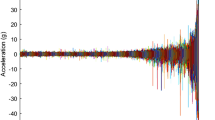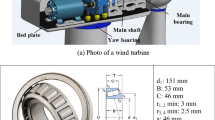Abstract
A good health index (HI) plays an important role in improving the reliability and accuracy of the prediction of remaining useful life (RUL) of rolling bearings. In order to better integrate degradation information contained in high-dimensional features, construct HIs with a good trendability and obtain satisfactory RUL prediction effect, this paper proposes a HI construction method based on spectral clustering and trendability enhancement strategy. Firstly, 28-dimensional time–frequency features are extracted. Secondly, the features are clustered based on the spectral clustering method. Thirdly, the sensitive feature set of degradation process is constructed based on the trendability optimization. Finally, based on the calculation of trendability indicators of sensitive feature set, HIs based on the trendability enhancement strategy are calculated, and its performance can be verified through RUL prediction based on Support Vector Regression (SVR). The vibration data set of XJTU-SY bearing accelerated degradation test was used to evaluate the proposed method. The experimental results showed that the HIs constructed by this method have good accuracy in RUL prediction, and have better trendability and predictability compared with Root Mean Square (RMS) indicators and HIs obtained based on traditional k-means clustering.
Access this chapter
Tax calculation will be finalised at checkout
Purchases are for personal use only
Similar content being viewed by others
References
Lei, Y., Li, N., Guo, L., et al.: Machinery health prognostics: A systematic review from data acquisition to RUL prediction. Mech. Syst. Signal Process. 104, 799–834 (2018)
El-Thalji, I., Jantunen, E.: A summary of fault modelling and predictive health monitoring of rolling element bearings. Mech. Syst. Signal Process. 60–61, 252–272 (2015)
Kumar, A., Kumar, R.: Role of signal processing, modeling and decision making in the diagnosis of rolling element bearing defect: a review. J. Nondestruct. Eval. 38(1), 5 (2019)
Ali, J.B., Chebel-Morello, B., Saidi, L., et al.: Accurate bearing remaining useful life prediction based on Weibull distribution and artificial neural network. Mech. Syst. Signal Process. 56–57, 150–172 (2015)
Rai, A., Kim, J.M.: A novel health indicator based on the Lyapunov exponent, a probabilistic self-organizing map, and the Gini-Simpson index for calculating the RUL of bearings. Measurement 164, 108002 (2020)
Zhu, J., Nostrand, T., Spiegel, C., et al.: Survey of condition indicators for condition monitoring systems. In: Annual Conference of the Prognostic and Health Management Society, vol. 1–13 (2014)
Li, N., Lei, Y., Lin, J., et al.: An improved exponential model for predicting remaining useful life of rolling element bearings. IEEE Trans. Industr. Electron. 62(12), 7762–7773 (2015)
Lei, Y., Li, N., Lin, J.: A new method based on stochastic process models for machine remaining useful life prediction. IEEE Trans. Instrum. Meas. 65(12), 2671–2684 (2016)
Yang, H., Sun, Z., Jiang, G., et al.: Remaining useful life prediction for machinery by establishing scaled-corrected health indicators. Measurement 163, 108035 (2020)
Wang, X., Jiang, B., Lu, N.: Adaptive relevant vector machine based RUL prediction under uncertain conditions. ISA Trans. 87, 217–224 (2019)
Chen, C., Xu, T., Wang, G., et al.: Railway turnout system RUL prediction based on feature fusion and genetic programming. Measurement 151, 107162 (2020)
Che, C., Wang, H., Fu, Q., et al.: Combining multiple deep learning algorithms for prognostic and health management of aircraft. Aerosp. Sci. Technol. 94, 105423 (2019)
Li, X., Zhang, W., Ding, Q.: Deep learning-based remaining useful life estimation of bearings using multi-scale feature extraction. Reliab. Eng. Syst. Saf. 182, 208–218 (2019)
Li, H., Wang, W., Huang, P., et al.: Fault diagnosis of rolling bearing using symmetrized dot pattern and density-based clustering. Measurement 152, 107293 (2020)
Yousefi, N., Coit, D.W., Song, S.: Reliability analysis of systems considering clusters of dependent degrading components. Reliab. Eng. Syst. Saf. 202, 107005 (2020)
Liu, J., Li, Q., Chen, W., et al.: A discrete hidden Markov model fault diagnosis strategy based on K-means clustering dedicated to PEM fuel cell systems of tramways. Int. J. Hydrogen Energy 43(27), 12428–12441 (2018)
Baraldi, P., Cannarile, F., Maio, F.D., et al.: Hierarchical k-nearest neighbours classification and binary differential evolution for fault diagnostics of automotive bearings operating under variable conditions. Eng. Appl. Artif. Intell. 56, 1–13 (2016)
Zhang, H., Chen, X., Zhang, X., et al.: Aero-engine bearing fault detection: a clustering low-rank approach. Mech. Syst. Sig. Process. 138, 106529 (2020)
Xiong, Y., Zhang, R., Zhang, F., et al.: A spectra partition algorithm based on spectral clustering for interval variable selection. Infrared Phys. Technol. 105, 103259 (2020)
Gao, M., Shi, G.Y.: Ship-handling behavior pattern recognition using AIS sub-trajectory clustering analysis based on the T-SNE and spectral clustering algorithms. Ocean Eng. 205, 106919 (2020)
Tong, T., Gan, J., Wen, G.: One-step spectral clustering based on self-paced learning. Pattern Recogn. Lett. 135, 8–14 (2020)
Zhu, X., Li, X., Zhang, S.: Graph PCA hashing for similarity search. IEEE Trans Multimedia 19(9), 2033–2044 (2017)
Luxburg, U.V.: A tutorial on spectral clustering. Stat. Comput. 17(4), 395–416 (2007)
Li, N., Lei, Y., Liu, Z., et al.: A particle filtering-based approach for remaining useful life predication of rolling element bearings. In: 2014 International Conference on Prognostics and Health Management, pp. 1–8 (2014)
Javed, K., Gouriveau, R., Zerhouni, N., et al.: A feature extraction procedure based on trigonometric functions and cumulative descriptors to enhance prognostics modeling. In: 2013 IEEE Conference on Prognostics and Health Management (PHM), pp. 1–7 (2013)
Zhang, B., Zhang, L., Xu, J.: Degradation feature selection for remaining useful life prediction of rolling element bearings. Qual. Reliab. Eng. Int. 32(2), 547–554 (2016)
Wang, B., Lei, Y., Li, N., et al.: A hybrid prognostics approach for estimating remaining useful life of rolling element bearings. IEEE Trans. Reliab. 69(1), 401–412 (2020)
Ahmad, M.S., Adnan, S.M., Zaidi, S., et al.: A novel support vector regression (SVR) model for the prediction of splice strength of the unconfined beam specimens. Constr. Build. Mater. 248, 118475 (2020)
Acknowledgements
This research was financially supported by National Natural Science Foundation of China (No. 52005335), Shanghai Sailing Program (No. 18YF1417800).
Author information
Authors and Affiliations
Corresponding author
Editor information
Editors and Affiliations
Rights and permissions
Copyright information
© 2021 Springer Nature Singapore Pte Ltd.
About this paper
Cite this paper
Jiang, H., Luo, J., Shao, Y., Ma, Q., Pan, H. (2021). A New Health Indicator Construction Approach and Its Application in Remaining Useful Life Prediction of Bearings. In: Zhang, H., Yang, Z., Zhang, Z., Wu, Z., Hao, T. (eds) Neural Computing for Advanced Applications. NCAA 2021. Communications in Computer and Information Science, vol 1449. Springer, Singapore. https://doi.org/10.1007/978-981-16-5188-5_21
Download citation
DOI: https://doi.org/10.1007/978-981-16-5188-5_21
Published:
Publisher Name: Springer, Singapore
Print ISBN: 978-981-16-5187-8
Online ISBN: 978-981-16-5188-5
eBook Packages: Computer ScienceComputer Science (R0)




